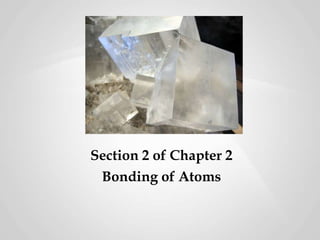
section 2, chapter 2
- 1. Section 2 of Chapter 2 Bonding of Atoms
- 2. Properties of electrons Electron Shells: Electrons encircle the nucleus in discrete orbits, called electron shells. Each shell can contain only a fixed number of electrons. 1st shell holds 2 electrons 2nd shell holds 8 electrons 3rd shell holds 8 electrons Octet rule: Except for the 1st shell, each electron shell holds up to 8 electrons * Lower shells are filled first.
- 3. Helium Atomic number = 2 Atomic weight = 4 (2 electrons fill the 1st electron shell) Carbon Atomic number = 6 Atomic weight = 12 (The first 2 electrons fill the inner shell, and the remaining 4 electrons are placed the 2nd electron shell).
- 4. Ions Ions are atoms that readily gain or loose electrons Cation: an ion that looses electrons • Cations are positively charged ions Anion: an ion that gains electrons •Anions are negatively charged ions
- 5. Example of a cation Sodium (Na) atomic number = 11 atomic weight = 23 Na+ = Sodium cation Only 1 lone electron sits in the outer shell. This electron is unpaired and is easily lost, forming the sodium cation.
- 6. Example of an anion Chlorine (Cl) atomic number = 17 atomic weight = 35 Cl - = Chloride anion 7 electrons fill the outer shell of chlorine, leaving room for 1 more electron. Chlorine readily accepts one electron, creating the chloride anion.
- 7. Ionic Bond Ionic bonds are formed when the oppositely charged particles attract. Figure 2.4 (a) An ionic bond forms when on atom gains and another atom looses electrons, and then (b) oppositely charged ions attract.
- 9. Covalent Bonds Covalent bonds are formed when atoms share electrons. Example: A hydrogen molecule (H2) is formed when two hydrogen atoms share their single electron. H+H H2
- 10. Covalent Bonds of water Water consist of oxygen covalently bonded to two hydrogen atoms. Structural Formula: depicts the covalent bonds of a molecule as lines. Molecular Formula: is a shorthand notation for representing molecules.
- 11. Oxygen joined to two hydrogen atoms by single bonds Two oxygen atoms joined by a double bond. A Carbon atom joined to hydrogen by a single bond and to nitrogen by a triple bond.
- 12. Nonpolar covalent bonds Nonpolar covalent bonds occur when the atoms share the electrons equally, so the molecule has no overall charge. Two hydrogen atoms share their electrons equally. Thus, the hydrogen molecule has no overall charge and is nonpolar.
- 13. Polar covalent bonds Polar bonds have an unequal distribution of electrons. One portion of the atom has a higher affinity for electrons than the rest of the molecule (electronegative). Slightly negative end Slightly positive end Water is a polar molecule because the oxygen atom (with 8 protons) tends to pull the electrons away from hydrogen. The oxygen end has a slight negative charge, while the hydrogen end has a slight positive charge.
- 14. Hydrogen bonds Occur when the slightly positive (hydrogen) end of a polar molecule weakly attracts to the slightly negative end of another molecule. Hydrogen Bonds: • Form weak bonds at room temperature, but are strong enough to form ice • Stabilize large proteins, DNA, and RNA End of Section 2, Chapter 2